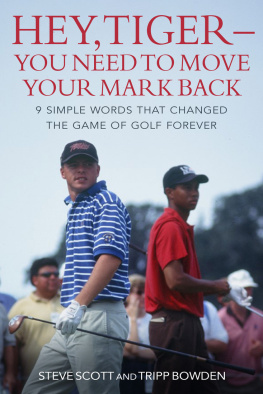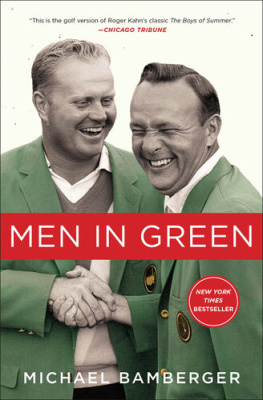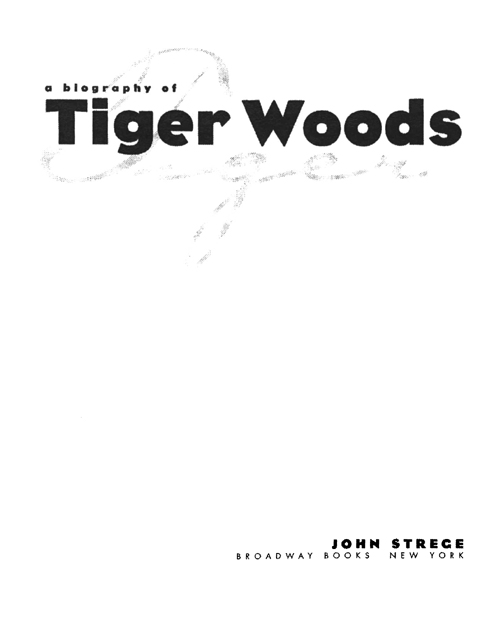Tiger
PRAISE FOR JOHN STREGES TIGER:
Crisp and canny the merit of this book is in the authors command of detail, the real feel for the velocity of Woods rise and the sense of inevitability that surrounded him, even when he was a toddler.
Los Angeles Times
Strege chronicles the golfers achievements without losing sight of the human being. The result is a series of captivating episodes covering Woods feats (and defeats), his mental approach to golf, and his sense of personal and social responsibility.
Hartford Courant
Gets behind the scenes in ways other millions of words about Woods have not.
Detroit Free Press
A well-balanced, inspiring book.
Publishers Weekly
A LSO BY J OHN S TREGE
Off the Record

A hardcover edition of this book was published in 1997 by Broadway Books.
Tiger: A Biography of Tiger Woods. Copyright 1997 by John Strege. All rights reserved. No part of this book may be reproduced or transmitted in any form or by any means, electronic or mechanical, including photocopying, recording, or by any information storage and retrieval system, without written permission from the publisher. For information, address Broadway Books, a division of Bantam Doubleday Dell Publishing Group, Inc., 1540 Broadway, New York, NY 10036.
BROADWAY BOOKS and its logo, a letter B bisected on the diagonal, are trademarks of Broadway Books, a division of Bantam Doubleday Dell Publishing Group. Inc.
The Library of Congress has catalogued the hardcover edition as:
Strege, John.
Tiger: a biography of Tiger Woods / by John Strege. 1st ed.
p. cm.
1. Woods, Tiger. 2. GolfersUnited StatesBiography.
I. Title.
GV964.W66S87 1997
796.352 092dc21
[B]
97-9057
eISBN: 978-0-307-75691-6
v3.1
F OR M ARLENE,
WITH LOVE AND A DMIRATION
contents
acknowledgments
The doormat on the front porch of the Woodses home in Cypress, California, said, Duffers Welcome, which I interpreted to mean me. And so I stepped across their threshold and into their lives and was graciously given the best seat in the house to watch one of sports most fascinating stones unfold.
I wish to express my appreciation to Tiger for permitting me to witness his development as a golfer and as a person from a unique perspective. Over the years, he has been generous with his time and unfailingly polite, and I have treasured this opportunity.
I am indebted to his parents, Earl and Kultida Woods, who are rightfully proud of their son and their role in his success. When you write about fourteen-year-old athletes, even those as bright as Tiger, they are seldom useful sources of information. As a result, you tend to lean on the parents, who become invaluable resources, as was the case here. From a professional relationship a friendship evolved with Earl and Kultida, and I have cherished that more than they know.
I owe a debt of gratitude that can never be repaid to Larry Dorman, the esteemed golf writer for the New York Times, without whose help this project would not have been possible. I am proud to call him my friend. I would also like to thank another friend, Jaime Diaz, for his unending support over the years. For my money, Diaz and Dorman are the two best golf writers in America.
My agent, Freya Manston, is a persistent woman who made no promises but responded as though she had. She is a remarkable woman and a friend, and her tireless efforts on my behalf will never be forgotten.
Of incalculable help was Dave Strege, an accomplished journalist and a preeminent outdoors writer. Thanks also to his wonderful wife, Cindy, for permitting me to borrow him.
Special thanks to Rudy Duran, the golf pro responsible for pointing a four-year-old Tiger in the right direction. My appreciation for his selfless contributions to this project is limitless. Thanks also to Jay Brunza, an officer and a gentleman; to Butch Harmon, a pros pro and the best teacher in the game; and to John Merchant, whose role in and passion for advancing minority participation in golf should not be overlooked.
For all those who shared their recollectionsnotably Don Crosby, Mike Kruse, Wally Goodwin, Conrad Ray, Jake Poe, Eri Crum, and Tom Sargentyou have my deepest appreciation.
Thanks to my colleagues in the press tent for their contributions to, and/or support of, this book, notably Mark Soltau, Paul Lester, Robinson Holloway, T. R. Reinman, John Marvel, Lee Patterson, Wes Seeley, and Mark Mitchell.
I would be remiss in failing to acknowledge those most important to me; their enthusiasm and encouragement was of inestimable help. They include, first and foremost, my mother and father, Dorothy and Bill Strege, as well as Liz and Bill Spencer, Teresa and Leonard Strege, Trina and Howard Miller, Lorraine Allred, Craig Hoelzel, Harry Hoelzel, and Dorothy and Bob Mericle. Thanks also to Debbie Johnson for her assistance.
Chuck Scott has provided counsel and friendship and Steve Bisheff has been a mentor and a friend, and I am grateful to both. Thanks as well to Tom Bonk for his friendship and moral support through a sometimes hectic and difficult time and to Robert Barth and Joy Gibney.
My indefatigable editor at Broadway Books, Suzanne Oaks, as friendly as she is skillful, kept this project on track without once losing patience with me. It was a privilege to have had the opportunity to work with her. I am grateful also to her assistant, Ann Campbell, for her help and timely words of encouragement. Finally, my heartfelt appreciation to William Shinker, the publisher of Broadway Books, for providing me with this opportunity.
introduction
An eerie quiet descended over the valley, a lush landscape of farmland and pine trees through which two golf courses had been built near the Sunset Highway twenty miles west of Portland, Oregon. It was so quiet you could hear a putt drop, if one was inclined to dropa remote possibility given the factors conspiring against the putt in question.
It might have measured thirty feet had it not been attached to the rack and stretched by the pressure of the situation, the thirty-fifth hole of the final match of the ninety-sixth United States Amateur Championship. Thirty feet or thirty miles, the distance represented a journey across time, ninety-six years of reel reduced to this, a single frame frozen in the minds eye: Tiger Woods putting, his quest for a historic and unprecedented third consecutive U.S. Amateur championship hanging in the balance.
This was potentially another in a series of defining moments in the career of Tiger Woods, the kind that compels him to elevate his gameostensibly by the sheer force of his willto meet the enormity of a task. Jay Brunza, his longtime sports psychologist, compares Woodss innate ability to make crucial putts to that of Nicklaus. They both seem to will the ball into the hole, he said.
The crowd on the Witch Hollow Course had grown to more than fifteen thousand, the largest to witness a U.S. Amateur final since Bobby Jones pursued the Grand Slam at Merion in 1930. The people were entranced by the precocious and seemingly indomitable Woods, a rare multiethnic presence in a game with eighteen greens, but noticeably fewer blacks. They had put down their money to see him apply the final flourish to his amateur legacy, and they watched in stunned disbelief as he displayed an unsteady hand and, at the midway point of the thirty-six-hole match, fell behind to Steve Scott by five holes.







